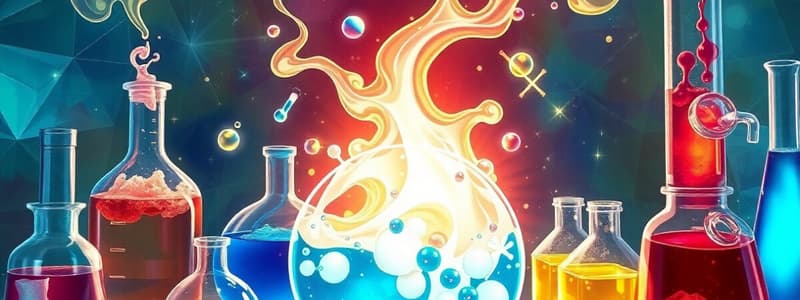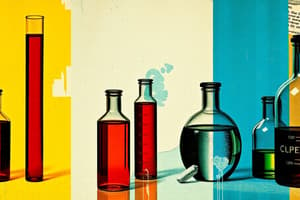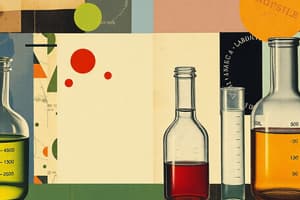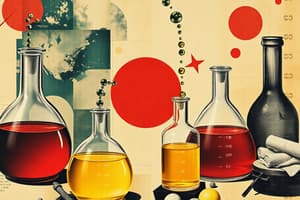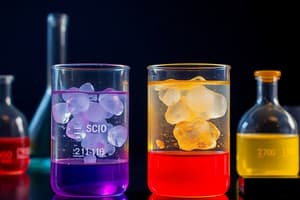Podcast
Questions and Answers
[Blank] indicators change their odour in acidic or basic media.
[Blank] indicators change their odour in acidic or basic media.
Olfactory
To test for acids and bases using onions, finely chopped onions are taken in a plastic bag along with some strips of clean ______.
To test for acids and bases using onions, finely chopped onions are taken in a plastic bag along with some strips of clean ______.
cloth
[Blank] solutions are collected from the science laboratory for testing.
[Blank] solutions are collected from the science laboratory for testing.
Acidic
[Blank] paper is used to identify the contents of each test tube.
[Blank] paper is used to identify the contents of each test tube.
Indicators show if a substance is acidic or basic by a change in ______.
Indicators show if a substance is acidic or basic by a change in ______.
[Blank] acid (HCl) is collected from the science laboratory.
[Blank] acid (HCl) is collected from the science laboratory.
Sulphuric acid has the chemical formula ______.
Sulphuric acid has the chemical formula ______.
[Blank] hydroxide (NaOH) is a basic solution.
[Blank] hydroxide (NaOH) is a basic solution.
Ammonium hydroxide has the chemical formula ______.
Ammonium hydroxide has the chemical formula ______.
To distinguish between an acidic and a basic solution using only red litmus paper, observe if the litmus turns ______, indicating a base.
To distinguish between an acidic and a basic solution using only red litmus paper, observe if the litmus turns ______, indicating a base.
The acids provided, such as hydrochloric acid (HCl) and sulphuric acid (H2SO4), will ______ blue litmus paper.
The acids provided, such as hydrochloric acid (HCl) and sulphuric acid (H2SO4), will ______ blue litmus paper.
Substances that indicate whether a solution is acidic or basic through a change in color are called acid-base ______.
Substances that indicate whether a solution is acidic or basic through a change in color are called acid-base ______.
[Blank] indicators, like finely chopped onions, change their odor in acidic or basic media.
[Blank] indicators, like finely chopped onions, change their odor in acidic or basic media.
Phenolphthalein remains colorless in ______ solutions but turns pink in basic solutions.
Phenolphthalein remains colorless in ______ solutions but turns pink in basic solutions.
A solution with a high concentration of hydroxide ions (OH-) is considered ______.
A solution with a high concentration of hydroxide ions (OH-) is considered ______.
Methyl orange turns ______ in acidic solutions and yellow in basic solutions.
Methyl orange turns ______ in acidic solutions and yellow in basic solutions.
Calcium hydroxide [Ca(OH)2] and potassium hydroxide (KOH) are examples of strong ______.
Calcium hydroxide [Ca(OH)2] and potassium hydroxide (KOH) are examples of strong ______.
Acetic acid (CH3COOH), found in vinegar, is a ______ acid.
Acetic acid (CH3COOH), found in vinegar, is a ______ acid.
Ammonium hydroxide (NH4OH) is considered a ______ base because it does not fully dissociate in water.
Ammonium hydroxide (NH4OH) is considered a ______ base because it does not fully dissociate in water.
In the absence of any other indicator, the test tube containing distilled water will not change the color of red litmus paper, whereas the ______ solution will turn red litmus paper blue, and the acidic solution will keep it red.
In the absence of any other indicator, the test tube containing distilled water will not change the color of red litmus paper, whereas the ______ solution will turn red litmus paper blue, and the acidic solution will keep it red.
The reaction between an acid and a base is known as a ______ reaction, which results in the formation of salt and water.
The reaction between an acid and a base is known as a ______ reaction, which results in the formation of salt and water.
[Blank] indicators are substances that exhibit a change in odor when exposed to acidic or basic media, enabling the differentiation between the two.
[Blank] indicators are substances that exhibit a change in odor when exposed to acidic or basic media, enabling the differentiation between the two.
The strength of an acid or a base is measured using the ______ scale, where values below 7 indicate acidity, values above 7 indicate basicity, and a value of 7 indicates neutrality.
The strength of an acid or a base is measured using the ______ scale, where values below 7 indicate acidity, values above 7 indicate basicity, and a value of 7 indicates neutrality.
When testing solutions with indicators, it is important to use a ______ watch-glass to avoid contamination and ensure accurate color observation.
When testing solutions with indicators, it is important to use a ______ watch-glass to avoid contamination and ensure accurate color observation.
Hydrochloric acid (HCl) is an example of a ______ acid, while acetic acid ($CH_3COOH$) is an example of a weak acid based on their degree of ionization in water.
Hydrochloric acid (HCl) is an example of a ______ acid, while acetic acid ($CH_3COOH$) is an example of a weak acid based on their degree of ionization in water.
Calcium hydroxide [$Ca(OH)_2$] is considered a strong base because it completely dissociates into ions in water. However, due to its low solubility in water, it is considered a ______ base.
Calcium hydroxide [$Ca(OH)_2$] is considered a strong base because it completely dissociates into ions in water. However, due to its low solubility in water, it is considered a ______ base.
When using cloth strips prepared with chopped onions as olfactory indicators, a change in odor can indicate the presence of an acid or a base; the acid typically ______ or diminishes the onion's odor, while the base may intensify it or alter its characteristic scent.
When using cloth strips prepared with chopped onions as olfactory indicators, a change in odor can indicate the presence of an acid or a base; the acid typically ______ or diminishes the onion's odor, while the base may intensify it or alter its characteristic scent.
The chemical behavior of acids and bases is primarily determined by their ability to donate or accept ______ ions, respectively, influencing the concentration of these ions in solution.
The chemical behavior of acids and bases is primarily determined by their ability to donate or accept ______ ions, respectively, influencing the concentration of these ions in solution.
During laboratory activities involving acids and bases, it is essential to wear appropriate personal protective equipment (PPE) such as gloves and goggles to prevent chemical burns and eye damage due to their corrosive nature. Always add ______ to water slowly while stirring.
During laboratory activities involving acids and bases, it is essential to wear appropriate personal protective equipment (PPE) such as gloves and goggles to prevent chemical burns and eye damage due to their corrosive nature. Always add ______ to water slowly while stirring.
Given only red litmus paper and three unlabeled test tubes containing distilled water, an acidic solution, and a basic solution, the identification process hinges on the principle that acids ______ red litmus, bases turn red litmus ______, and distilled water produces ______ observable color change.
Given only red litmus paper and three unlabeled test tubes containing distilled water, an acidic solution, and a basic solution, the identification process hinges on the principle that acids ______ red litmus, bases turn red litmus ______, and distilled water produces ______ observable color change.
When employing olfactory indicators to differentiate between a strong monoprotic acid and a weak diprotic acid of equivalent molarity, the comparative change in odor intensity would be more pronounced in the presence of the ______ acid due to its heightened degree of ______.
When employing olfactory indicators to differentiate between a strong monoprotic acid and a weak diprotic acid of equivalent molarity, the comparative change in odor intensity would be more pronounced in the presence of the ______ acid due to its heightened degree of ______.
If a novel amphoteric oxide demonstrates an ability to react with both dilute hydrochloric acid and concentrated sodium hydroxide, but exhibits a marked preference for the latter, the relative ______ of the oxide suggests an augmented ______ character.
If a novel amphoteric oxide demonstrates an ability to react with both dilute hydrochloric acid and concentrated sodium hydroxide, but exhibits a marked preference for the latter, the relative ______ of the oxide suggests an augmented ______ character.
In a scenario where methyl orange is used to titrate a solution of potassium hydroxide with hydrochloric acid, the endpoint color transition occurs due to the ______ of the indicator's molecular structure, induced by fluctuations in ______ concentration.
In a scenario where methyl orange is used to titrate a solution of potassium hydroxide with hydrochloric acid, the endpoint color transition occurs due to the ______ of the indicator's molecular structure, induced by fluctuations in ______ concentration.
When gaseous ammonia is dissolved in water, the subsequent equilibrium established favors the formation of ______ ions and ______ ions, thereby rendering the solution alkaline and capable of turning litmus paper ______.
When gaseous ammonia is dissolved in water, the subsequent equilibrium established favors the formation of ______ ions and ______ ions, thereby rendering the solution alkaline and capable of turning litmus paper ______.
The phenomenon of acid rain, characterized by a pH lower than 5.6, is primarily attributed to the dissolution of atmospheric ______ and ______ oxides, leading to the formation of dilute ______ and ______ acids.
The phenomenon of acid rain, characterized by a pH lower than 5.6, is primarily attributed to the dissolution of atmospheric ______ and ______ oxides, leading to the formation of dilute ______ and ______ acids.
In the context of Lewis acid-base theory, the reaction between boron trifluoride ($BF_3$) and ammonia ($NH_3$) results in the formation of a coordinate covalent bond, wherein $BF_3$ acts as the ______ and $NH_3$ functions as the ______.
In the context of Lewis acid-base theory, the reaction between boron trifluoride ($BF_3$) and ammonia ($NH_3$) results in the formation of a coordinate covalent bond, wherein $BF_3$ acts as the ______ and $NH_3$ functions as the ______.
The autoprotolysis of water, represented by the equilibrium $2H_2O \rightleftharpoons H_3O^+ + OH^-$, implies that even in pure water, there exist hydronium and hydroxide ions, with their concentrations at 25°C defining the ______ of water as $1.0 \times 10^{-14}$, a benchmark reflective of water's inherent ______.
The autoprotolysis of water, represented by the equilibrium $2H_2O \rightleftharpoons H_3O^+ + OH^-$, implies that even in pure water, there exist hydronium and hydroxide ions, with their concentrations at 25°C defining the ______ of water as $1.0 \times 10^{-14}$, a benchmark reflective of water's inherent ______.
When titrating a polyprotic acid, such as sulfuric acid ($H_2SO_4$), with a strong base, the titration curve exhibits multiple equivalence points, each corresponding to the sequential ______ of protons. These equivalence points are distinguishable by inflections in the curve and can be precisely determined using appropriate ______.
When titrating a polyprotic acid, such as sulfuric acid ($H_2SO_4$), with a strong base, the titration curve exhibits multiple equivalence points, each corresponding to the sequential ______ of protons. These equivalence points are distinguishable by inflections in the curve and can be precisely determined using appropriate ______.
Consider a scenario where an aqueous solution of a weak acid, with an initial concentration of 0.1 M and a dissociation constant ($K_a$) of $1.8 \times 10^{-5}$, is subjected to dilution. The degree of dissociation of the weak acid will ______ as the solution is diluted, in accordance with ______'s dilution law.
Consider a scenario where an aqueous solution of a weak acid, with an initial concentration of 0.1 M and a dissociation constant ($K_a$) of $1.8 \times 10^{-5}$, is subjected to dilution. The degree of dissociation of the weak acid will ______ as the solution is diluted, in accordance with ______'s dilution law.
An indicator like litmus paper changes ______ depending on whether it is in an acidic or basic solution.
An indicator like litmus paper changes ______ depending on whether it is in an acidic or basic solution.
To test a solution with red litmus paper, observe whether it turns ______, which indicates a basic solution.
To test a solution with red litmus paper, observe whether it turns ______, which indicates a basic solution.
Substances whose odor changes in acidic or basic media are called ______ indicators.
Substances whose odor changes in acidic or basic media are called ______ indicators.
If a substance does not change the color of red litmus paper, it could either be ______ or neutral.
If a substance does not change the color of red litmus paper, it could either be ______ or neutral.
Hydrochloric acid has the chemical formula ______.
Hydrochloric acid has the chemical formula ______.
The chemical formula for sulfuric acid is ______.
The chemical formula for sulfuric acid is ______.
The chemical formula for acetic acid is ______.
The chemical formula for acetic acid is ______.
Calcium hydroxide has the chemical formula ______.
Calcium hydroxide has the chemical formula ______.
To distinguish between distilled water, an acidic solution, and a basic solution using only red litmus paper, one would first test each solution; the one turning the red litmus ______ is basic, while the other two require an additional step of testing the effect of the basic solution on the remaining two to see which among them restores the litmus color back to red, thus identifying the ______ solution.
To distinguish between distilled water, an acidic solution, and a basic solution using only red litmus paper, one would first test each solution; the one turning the red litmus ______ is basic, while the other two require an additional step of testing the effect of the basic solution on the remaining two to see which among them restores the litmus color back to red, thus identifying the ______ solution.
The exploitation of characteristic shifts in the frequency of surface plasmon resonance, induced by selective physisorption of volatile organic compounds onto a functionalized plasmon-resonant substrate represents a frontier in ______ indicator technology, enabling the quantification, at parts-per-billion sensitivities, of complex gaseous mixtures, an advancement that transcends traditional olfactory methods.
The exploitation of characteristic shifts in the frequency of surface plasmon resonance, induced by selective physisorption of volatile organic compounds onto a functionalized plasmon-resonant substrate represents a frontier in ______ indicator technology, enabling the quantification, at parts-per-billion sensitivities, of complex gaseous mixtures, an advancement that transcends traditional olfactory methods.
Flashcards
Red litmus paper
Red litmus paper
Used to test if a solution is acidic or basic.
Acidic solution
Acidic solution
A solution with a pH less than 7, turns red litmus blue.
Basic solution
Basic solution
A solution with a pH greater than 7, turns red litmus blue.
Indicators
Indicators
Signup and view all the flashcards
Phenolphthalein
Phenolphthalein
Signup and view all the flashcards
Methyl orange
Methyl orange
Signup and view all the flashcards
Olfactory indicators
Olfactory indicators
Signup and view all the flashcards
pH scale
pH scale
Signup and view all the flashcards
Hydrochloric acid
Hydrochloric acid
Signup and view all the flashcards
Sodium hydroxide
Sodium hydroxide
Signup and view all the flashcards
Testing with red litmus
Testing with red litmus
Signup and view all the flashcards
Phenolphthalein color change
Phenolphthalein color change
Signup and view all the flashcards
Methyl orange response
Methyl orange response
Signup and view all the flashcards
Testing acids in lab
Testing acids in lab
Signup and view all the flashcards
Acid examples
Acid examples
Signup and view all the flashcards
Base examples
Base examples
Signup and view all the flashcards
Indicators usage
Indicators usage
Signup and view all the flashcards
Observing color changes
Observing color changes
Signup and view all the flashcards
Laboratory acids and bases
Laboratory acids and bases
Signup and view all the flashcards
Identifying test tube contents
Identifying test tube contents
Signup and view all the flashcards
Lab acids
Lab acids
Signup and view all the flashcards
Lab bases
Lab bases
Signup and view all the flashcards
Color change indicators
Color change indicators
Signup and view all the flashcards
Testing indicators
Testing indicators
Signup and view all the flashcards
Observation table
Observation table
Signup and view all the flashcards
Testing method
Testing method
Signup and view all the flashcards
Chopped onions test
Chopped onions test
Signup and view all the flashcards
Color changes
Color changes
Signup and view all the flashcards
Indicators with acids
Indicators with acids
Signup and view all the flashcards
Indicators with bases
Indicators with bases
Signup and view all the flashcards
Hydrochloric acid tests
Hydrochloric acid tests
Signup and view all the flashcards
Sodium hydroxide tests
Sodium hydroxide tests
Signup and view all the flashcards
Phenolphthalein usage
Phenolphthalein usage
Signup and view all the flashcards
Observing color with indicators
Observing color with indicators
Signup and view all the flashcards
Testing with indicators
Testing with indicators
Signup and view all the flashcards
Red litmus paper test
Red litmus paper test
Signup and view all the flashcards
Chemical properties of acids
Chemical properties of acids
Signup and view all the flashcards
Chemical properties of bases
Chemical properties of bases
Signup and view all the flashcards
Hydrochloric acid testing
Hydrochloric acid testing
Signup and view all the flashcards
Sodium hydroxide testing
Sodium hydroxide testing
Signup and view all the flashcards
Onion test method
Onion test method
Signup and view all the flashcards
Observing indicators
Observing indicators
Signup and view all the flashcards
Study Notes
Acids and Bases in the Laboratory
- Collect solutions: hydrochloric acid (HCl), sulfuric acid (H₂SO₄), nitric acid (HNO₃), acetic acid (CH₃COOH), sodium hydroxide (NaOH), calcium hydroxide [Ca(OH)₂], potassium hydroxide (KOH), magnesium hydroxide [Mg(OH)₂], and ammonium hydroxide (NH₄OH).
- Test solutions: Place a drop of each solution on a watch glass and add drops of red litmus, blue litmus, phenolphthalein, and methyl orange solutions. Record the color changes for each solution with each indicator. Note observations in a table. Be thorough in your record keeping.
- Tabulate observations: Create a table to meticulously record the results for each solution and its reaction with each indicator like red litmus solution, blue litmus solution, phenolphthalein solution, and methyl orange solution. Include the sample solution tested.
Olfactory Indicators
- Onion strips: Use finely chopped onions wrapped in clean cloth and stored overnight in a refrigerator to create odor indicators.
- Testing: Test the odor of the onion cloth strips.
- Acid/base reaction: Apply drops of dilute hydrochloric acid (HCl) to one strip and dilute sodium hydroxide (NaOH) to the other to observe odor changes. These changes of odor are called olfactory indicators.
Studying That Suits You
Use AI to generate personalized quizzes and flashcards to suit your learning preferences.
